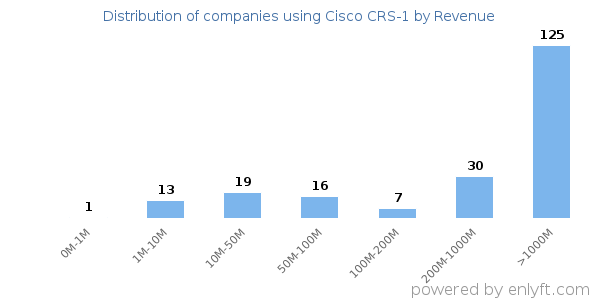Companies using Cisco CRS-1
We have data on 178 companies that use Cisco CRS-1. The companies using Cisco CRS-1 are most often found in United States and in the Telecommunications industry. Cisco CRS-1 is most often used by companies with >10000 employees and >1000M dollars in revenue. Our data for Cisco CRS-1 usage goes back as far as 8 years and 3 months.
If you’re interested in the companies that use Cisco CRS-1, you may want to check out Cisco 2900 Series Routers and Cisco Routers as well.
Who uses Cisco CRS-1?
| Company | HP Development Company, L.P. |
| Website | hp.com |
| Country | United States |
| Revenue | >1000M |
| Company Size | >10000 |
| Company | Tech Mahindra Ltd |
| Website | techmahindra.com |
| Country | India |
| Revenue | >1000M |
| Company Size | >10000 |
| Company | Microsoft |
| Website | microsoft.com |
| Country | United States |
| Revenue | >1000M |
| Company Size | >10000 |
| Company | Booz Allen Hamilton Holding Corporation |
| Website | boozallen.com |
| Country | United States |
| Revenue | >1000M |
| Company Size | >10000 |
| Company | Tata Consultancy Services Ltd |
| Website | tcs.com |
| Country | India |
| Revenue | >1000M |
| Company Size | >10000 |
| Company | Website | Country | Revenue | Company Size |
|---|---|---|---|---|
| HP Development Company, L.P. | hp.com | United States | >1000M | >10000 |
| Tech Mahindra Ltd | techmahindra.com | India | >1000M | >10000 |
| Microsoft | microsoft.com | United States | >1000M | >10000 |
| Booz Allen Hamilton Holding Corporation | boozallen.com | United States | >1000M | >10000 |
| Tata Consultancy Services Ltd | tcs.com | India | >1000M | >10000 |
Target Cisco CRS-1 customers to accomplish your sales and marketing goals.
Cisco CRS-1 Market Share and Competitors in Network Routers
We use the best indexing techniques combined with advanced data science to monitor the market share of over 15,000 technology products, including Network Routers. By scanning billions of public documents, we are able to collect deep insights on every company, with over 100 data fields per company at an average. In the Network Routers category, Cisco CRS-1 has a market share of about 0.2%. Other major and competing products in this category include:
Network Routers
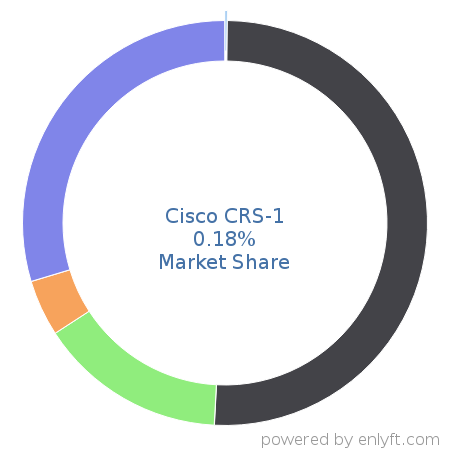

What is Cisco CRS-1?
CRS-1 is the first generation of Carrier Routing System launched in 2004. This replaced the Cisco 12000 routers which were used as core routers. Each slot of CRS-1 has a capacity of 40Gbit/s.
Top Industries that use Cisco CRS-1
Looking at Cisco CRS-1 customers by industry, we find that Telecommunications (29%), Information Technology and Services (17%) and Computer Software (6%) are the largest segments.
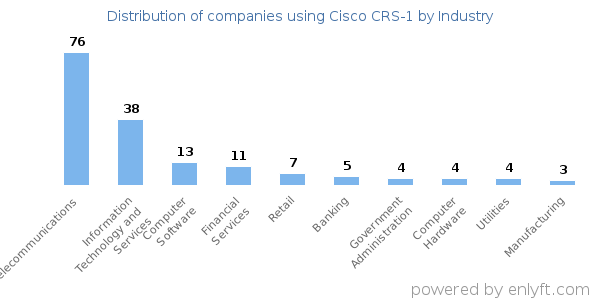
Top Countries that use Cisco CRS-1
57% of Cisco CRS-1 customers are in United States and 5% are in United Kingdom.
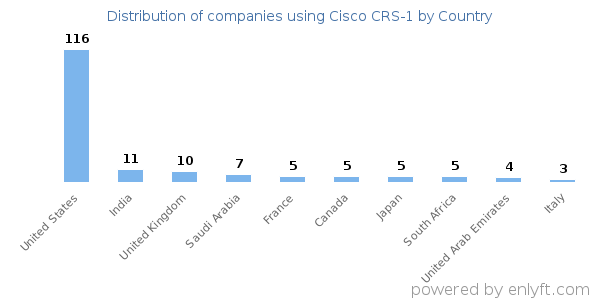
Distribution of companies that use Cisco CRS-1 based on company size (Employees)
Of all the customers that are using Cisco CRS-1, a majority (65%) are large (>1000 employees), 6% are small (<50 employees) and 24% are medium-sized.
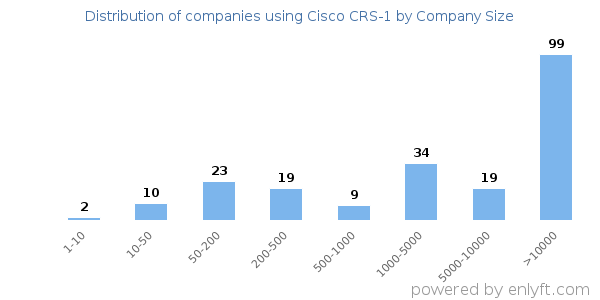
Distribution of companies that use Cisco CRS-1 based on company size (Revenue)
Of all the customers that are using Cisco CRS-1, a majority (65%) are large (>$1000M), 18% are small (<$50M) and 8% are medium-sized.
